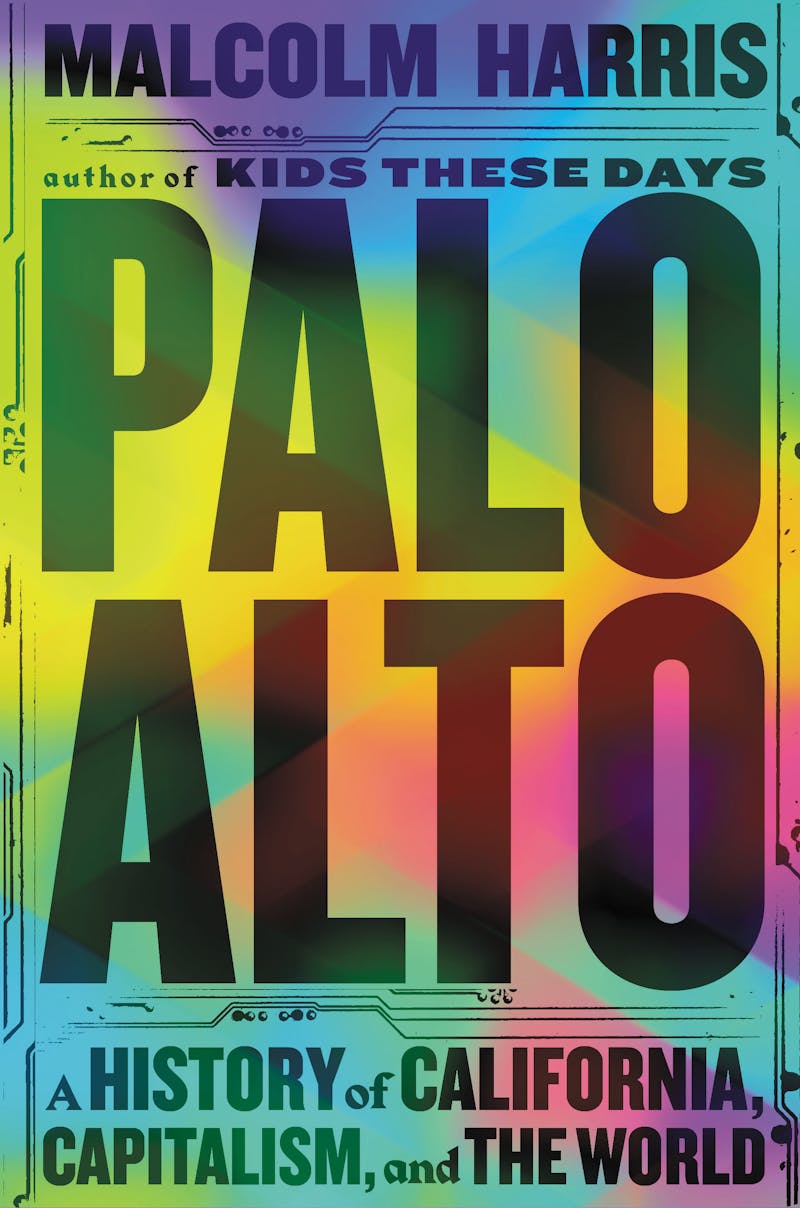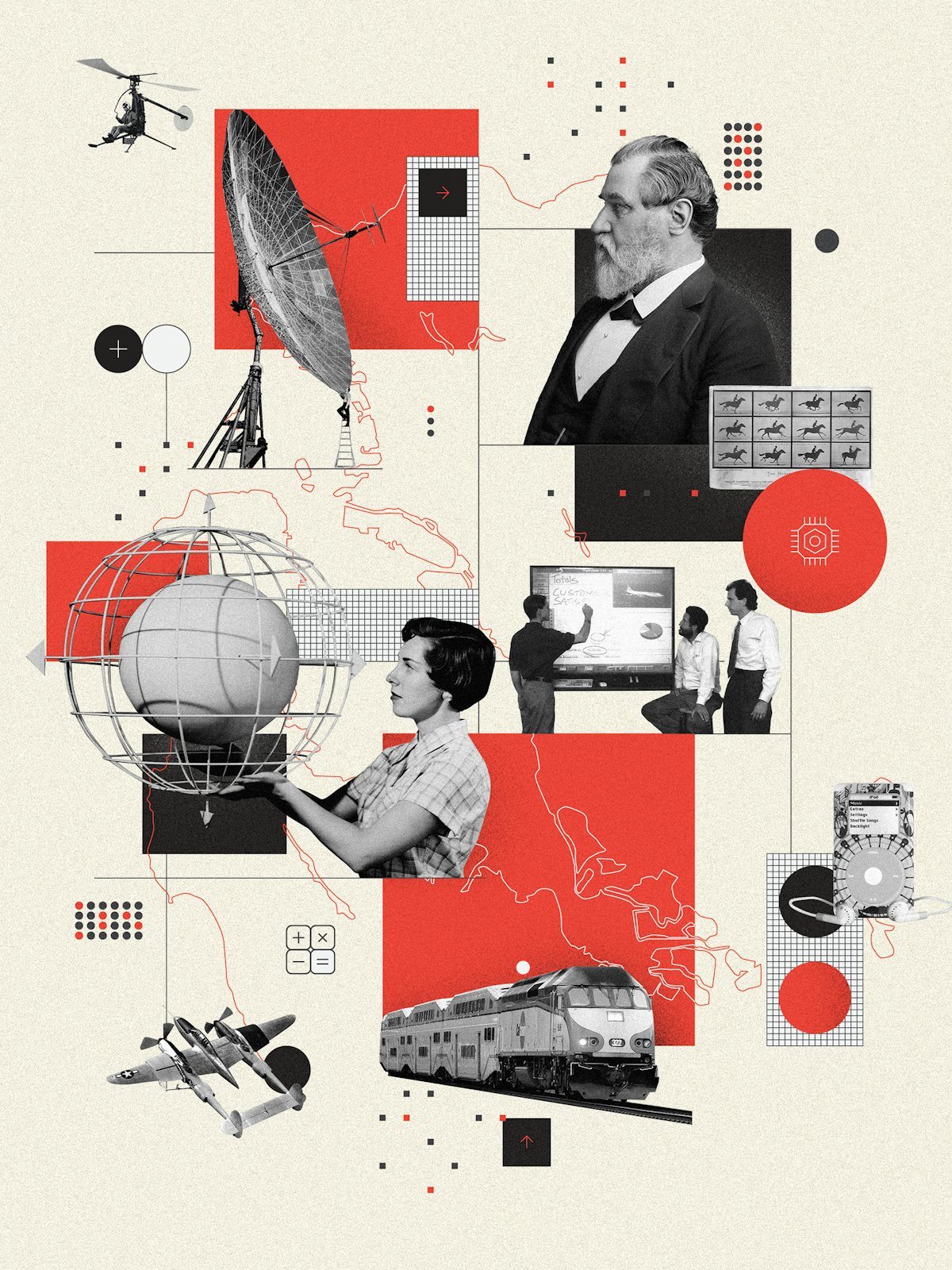California can seem incoherent from top to bottom. From the south, there’s San Diego, a militarized pleasure dome that has quite effectively obscured obscene inequality with sunshine, sand, and SeaWorld. There’s Los Angeles, a gorgeous paragon of health and wellness famous for its exhaust fumes and smog, the world’s glorious entertainment capital where the most common thing to catch on TV is a news story about the rich and powerful caging as many poor people as they possibly can. There’s the Central Valley, hundreds of miles of farms so fertile that they produce more than half of America’s fruits and vegetables, resting atop a desert so perpetually drought-stricken that its denizens have been pumping the state’s groundwater dry just to keep up with demand. And then, of course, there’s the Bay Area—the coolest, queerest, most radical place in the country—and also one rapidly being made unlivable by tech bros, their tough-on-crime allies, and all of the money spewed in their wake.
There are other stops on that road trip, too, from Orange County and the country’s most beautiful beaches to Death Valley, Mount Whitney, and the country’s most extreme environments. But the most influential spot on the map is a small, wealthy enclave called Palo Alto: the economic, cultural, and spiritual hub of Silicon Valley. Indeed, from the story of this small town one can extrapolate much of the recent history of the world. Or so argues the journalist Malcolm Harris in his recent book, Palo Alto: A History of California, Capitalism, and the World.

It’s in Palo Alto that the gospel of optimization emerged alongside an unprecedented surveillance infrastructure, the dogma of meritocracy growing in parallel with the huge creation of wealth, power, and stress. At the heart of this history is what Harris recognizes as Silicon Valley’s singular capitalist innovation: foregrounding the individual to forestall class struggle, convincing or compelling those individuals not only to work till they drop, but to feel they have no choice—and, sometimes, to like it. So far, at least, Palo Alto has succeeded.
Harris would know. He was, after all, raised in Palo Alto. And though he has long since come east, he retains a keen eye for the cultural and economic hallmarks and exports of his famous hometown. His first book, Kids These Days, tracked late capitalism’s grinding effects on Harris’s own generation. His latest, Palo Alto—an encyclopedic account of the history and impact of the town—feels like the culmination of his upbringing and career. It’s a stunning, Technicolor anvil of a book, starting before the founding of Stanford University and proceeding through the rise of the computer, the internet, suburbs, startups, and startup culture, ranging from wars of conquest to the Cold War to the war on terrorism to the tech industry’s war on privacy.
Palo Alto is far from the first history of the town, its residents, or its influence, but it is among the most capacious. Its strength lies in this very broadness, in the book’s determination to cover art and crime and drugs and economics and eugenics and robots and attempt to tie it all together as the story of modernity. To make sense of California, of our world, we must turn to this shining city by the bay.
When Harris was in the fourth grade, a substitute teacher in the town’s elementary school—Ohlone Elementary, named for the area’s Indigenous population—told him and his classmates an unvarnished truth: “You live in a bubble.” The students, who lived in well-manicured if unassuming suburban homes, in this temperate, vaguely countercultural-seeming city, conveniently located near some of the richest companies (and having one of the finest school systems) in the country, were confounded.
For this indiscretion, the substitute was fired and blacklisted. But the moment stuck with Harris. It prompted him to question Palo Alto’s own explanation for “why things were the way they were—why some people had big houses and others didn’t, why some people lived here and everyone else didn’t: They deserved it. Hard work and talent allowed some people to change the world single-handedly, and they earned whatever they got.” The kids in Palo Alto were at the forefront of a generation raised online and on meritocracy, a cohort that simultaneously had more access to information than ever before but also less time to explore than any previous crop of kids.
The myth really began to lose its luster a few years later, when a wave of suicides among Palo Alto High School students began. Hard work was supposed to lead to success. But Palo Alto’s young were working so hard that many took their own lives. In a characteristically chilling insight, Harris notes that the railroad many of his classmates used to kill themselves (stepping in front of the Caltrain) was also the railroad that brought a critical mass of Anglo settlers to California in the first place, setting the whole sick system in motion.
The man who built that railroad was Leland Stanford—a “notably unexceptional” figure Harris sees as a “slacker” who got very lucky. Born in Watervliet, New York, in 1824, young Stanford did as so many restless white men were doing in the mid–nineteenth century: He went west looking for an easy fortune, helping to displace (that is, enslave, expel, murder) Indigenous communities in the name of “improving” land that the settlers called “California.” California was booming, and, within a decade of landing in the new territory, Stanford—the dim front man for a quartet of ambitious merchants called “the Associates”—became governor. Later, capitalizing on the prestige of his single, undistinguished term in office, he became the president of a railroad line linking the resource-rich West Coast to East Coast money.
The railroads were built with federal largesse (a grant to the railroad barons of an amount of land whose total size was larger than Maryland’s) and exploited immigrant laborers. The result was an efficient system of transcontinental transportation, the creation of fabulously wealthy corporations and a tiny elite that ran them, and so much worker resentment directed at the barons that Stanford chose to relocate from a San Francisco mansion to an agricultural area to the south that was renamed for the region’s tall trees: Palo Alto.
In Palo Alto, Stanford came into his own and created a pseudo-feudal empire, at the heart of which was a horse farm. Not content merely to own horses (even the fastest horses), “Stanford the capitalist” embarked on “a serious scientific campaign regarding the improved performance of the laboring animal,” viewing horses as biological machines that could be perfected, made ever faster. The result was not a stable of super-horses but “a regimen of capitalist rationality” and an “exclusive focus on potential and speculative value” that Harris calls the “Palo Alto System.” It is the Palo Alto System that the rest of the book tracks, the unholy marriage of data and control in service of ever-greater profits.
Stanford, and especially his followers, were eager to put the Palo Alto System into practice, and they had just the place to do so: the university that the railroad baron had recently founded in his adopted hometown. Stanford University was established in 1885 to be a new type of school for new people in a newly colonized land, a training ground for the children of California on what was then the largest university campus in the United States.
The first students matriculated in 1891. Just two years later, Stanford was dead. The university’s president—the scientist David Starr Jordan—may or may not have then poisoned Stanford’s widow, Jane, in order to seize control. In any event, Stanford became Jordan’s school, and he turned it into a “home for high tech–research and development,” a “global headquarters of science” where administrators used the “science” of eugenics to recruit students and faculty. As early as 1909, Jordan and the head of his civil engineering department gave a recent alum access to the school’s high voltage laboratory, facilitating the creation of a long-range telegraphy company and ultimately making Stanford a hub for the burgeoning radio industry. Meanwhile, Jordan hired scholars like Lewis Terman, a social scientist who transformed primitive intelligence testing into a eugenic practice meant to weed out the evolutionarily fit from the rest (a technique that soon informed Stanford’s grading system). By the end of the Jordan era, Harris writes, the school excelled at producing both “mining engineers” and “intelligence prospectors,” investing in both young companies and young minds. Data and control in action.
Most influential of the Stanford men—and, indeed, the closest thing Palo Alto has to a main character—was the future U.S. President Herbert Hoover. One of the very first students to enroll at the college, Hoover was a middling scholar (he got zero A’s) but proved to be an excellent administrator (setting up a laundry service on campus and quickly subcontracting to other students to maximize his income). After graduation, he worked as a mining manager in colonized regions of Australia and China, went on to serve as U.S. commerce secretary, and ultimately became a catastrophic one-term president at the nadir of the Great Depression. Above all, Hoover was a zealous anti-communist. As a post-presidential roving public intellectual and political grandee, he threw himself projects like crushing unions (his California ranch was a site of significant labor unrest) and engineering post–World War II food aid to Germany to jump-start an economy friendly to powerful interests (he wanted workers “to be fed” but “not too much”). Among his most lasting legacies is the Hoover Institution, a reactionary think tank housed in a tower that looms—“phallic,” Harris notes—over Stanford.
During the Cold War, federal money flowed into Palo Alto, which grew rich making high-tech weapons and surveillance machinery. Stanford became an electronics laboratory and corporate landlord, with Lockheed Martin, Fairchild Semiconductor, and Hewlett-Packard conveniently taking up residence near campus (and near all those burgeoning engineers). The computer emerged from Palo Alto–based innovations: the vacuum tube, the silicon transistor, and the tech startup. A white, patriarchal, and conservative suburban culture emerged, too: engineer fathers taking the car to work to build missile systems, homemaker mothers carefully tending to single-family homes in restricted neighborhoods. Home prices skyrocketed. The wealth was built by (and on the backs of) subjugated Black migrants and Mexican and Asian immigrants, “just the way Hoover and his associates planned it.” Newcomers of color arriving in this rich corner of the Golden State were forced to find homes on the less desirable side of Highway 101, compete for dwindling agricultural jobs or nonunionized manufacturing jobs, and often settle for janitorial or other service positions.
At the same time, Palo Alto was expanding across the globe, with California companies like HP and Bank of America opening outposts in places like Böblingen, Germany, and Tokyo, respectively—two of the very sites the Allies had recently strategically bombed using Palo Alto tech. Elsewhere across the globe, colonized peoples were rising up, mirroring (and emerging in coordination with) resistance by marginalized peoples within the United States. The Black Panther Party—“the most important American communist party since the Popular Front”—exploded out of the Bay Area in the late 1960s, and student radicals (even at Stanford) protested incipient computer technology. Militants occupied Stanford’s Applied Electronics Lab for more than a week, bombed the Stanford Linear Accelerator Center, and invaded the Stanford Research Institute in an attempt to destroy its data storage drums. The students believed, correctly, that the school’s data processing research was integral to the U.S. war machine (having been specifically tipped off that the Stanford Research Institute was modeling an offensive in Vietnam). Yet increasingly militarized police and technologically sophisticated militaries quelled rebellion at home and abroad.
Even as U.S. factories began fleeing offshore in the 1960s and 1970s, “Silicon Valley came into its own.” While manufacturing flatlined, the tech industry soared. “White working-class homeowners,” Harris writes, “began to identify as white and homeowners more than as members of the working class”—nowhere more so than in California, in Palo Alto most of all—and they united to snuff out the remnants of the New Deal, electing leaders who deregulated industry and finance, privatized services, decimated unions, and delivered tax cuts. This move was not just political but cultural; California’s hippies turned classwide struggle into individualized, existential melodrama. Tripping and consciousness-raising supplanted collective action.
Uniting the political and the cultural with aplomb, California’s business leaders picked an affable brand-ambassador for free-market capitalism and Golden State individualism: Ronald Reagan. Led by an auto dealership magnate named Holmes Tuttle, they encouraged Reagan to run for office and bought him national airtime to sing their gospel. His presidential administration (including several California industrialists and arms dealers) cut social services to increase defense spending, funneled money and fancy Palo Alto tech (phone-intercept equipment, anti-aircraft missiles, etc.) to repressive local elites around the world, and helped turn education (previously an accessible incubator for all that pesky student radicalism) into a private market, leading students “to think of themselves in the same terms, as a walking, talking set of investments.”
The Palo Alto System was ascendant, as rich kids (like Bill Gates) and countercultural hustlers (like Steve Jobs) invested wisely and created not only companies but an accompanying mythology. The computer became personal, the internet became privatized, and coffee and cocaine both became fuels imported from abroad for Silicon Valley workers (in the startups and on the streets) to seek ever greater efficiency. New companies—Cisco, Oracle, Sun Microsystems, Netscape, Amazon, Google—burst forth and disrupted and extracted more and more, their innovations enabled by families of refugees living in basements in an increasingly unaffordable Bay Area, by workers laboring for pennies in highly surveilled factories across the global south.
The bright young companies promised “a new phase of postindustrial American expansion,” and regulators hastened to get out of the way. The bonds linking tech and the state only tightened after 9/11, when “Silicon Valley’s self-styled anti-authoritarians” saw exciting new moneymaking opportunities in supplying private data to public authorities bent on control. Mere months after the World Trade Center fell, Oracle had established a division to design and sell “homeland security and disaster recovery solutions,” and even though CEO Larry Ellison did not succeed in winning a contract for a national biometric identification system, Oracle’s revenue nonetheless doubled during the George W. Bush years.
“Palo Alto and Silicon Valley and Stanford and tech and the internet stood for more than the newest electronics,” Harris writes. “They stood for getting fucking rich.” With hefty state contracts, low taxes, easy access to credit, and little meaningful regulation, Palo Alto’s princelings could borrow and invest and attain monopolistic domination in record time, consequences be damned.

As the book gets closer and closer to the present, Harris acknowledges, it becomes increasingly “difficult to narrativize the latest phase of Silicon Valley history.” The dot-com and housing bubbles burst, anger swelled in the streets, yet Palo Alto’s capitalists just kept doubling down, aided and abetted and funded at every step by the supposed adults in the White House and on Wall Street. “The process selected for and elevated certain kinds of people. This, frankly, is where the story gets dumb.”
In recent Silicon Valley history, the dumbest and most outlandish and most venal individuals have made out the best (at least for a while). Elizabeth Holmes and Sunny Balwani of Theranos, Travis Kalanick of Uber, Adam Neumann of WeWork—these were people so lacking in creativity or ingenuity or even basic technical expertise that they “made Steve Jobs look like Steve Wozniak.” And all this was before Elon Musk oopsied his way into buying Twitter and then promptly revealed himself to be such a stunningly incompetent manager that he effectively gutted one of the world’s most important and popular communications platforms in a matter of weeks. Before the most celebrated crypto-exchange was revealed to be a massive Ponzi scheme run by a privileged polycule of twentysomethings.
Donald Trump’s success was the dumbest of all, his 2016 run for the presidency lavished with support from such Silicon Valley power players as Bob and Rebekah Mercer and Peter Thiel. For Thiel, a Stanford-educated tech entrepreneur and far-right culture warrior, Trump was a speculative bet that paid off handsomely. The new administration contracted with Thiel’s data analysis firm, Palantir, to the tune of billions of dollars, and Thiel himself became the Trump White House’s liaison to Silicon Valley. Shortly after Trump’s election, Thiel helped to engineer a much-publicized meeting between the new president and Silicon Valley’s elite: Jeff Bezos, Tim Cook, Elon Musk, Larry Page, Sheryl Sandberg, Eric Schmidt, and a slew of other tech executives. “After this meeting, these firms grew willing and even eager to deal with the government directly,” Harris recounts. “Amazon, Google, and Microsoft pursued and won tens of billions in security contracts, edging into the territory of traditional prime contractors.”
The Trump meeting was “a culmination of the Palo Alto System,” Harris concludes. This regional economy represented the world’s highest concentration of capital, and now its leaders could claim their place “at the center of the capitalist world,” pledging allegiance to data and control.
The Palo Alto System has prevailed far beyond the corridors of power. The gospel of relentless optimization has encroached on every area of life. It’s why homeowners and car owners rent out their abodes and their vehicles as part-time servants, why laborers in Amazon warehouses and overburdened hospitals urinate in bottles rather than halting for even a minute, why writers and artists and academics without institutional homes have to tell themselves that just one more gig might lead to some stability. It’s why one high school student in Palo Alto (where the suicide rate between 2003 and 2015 was three times the state average) could write, “We are not teenagers. We are lifeless bodies in a system that breeds competition, hatred, and discourages teamwork and genuine learning.” Today, individuals race to monetize their every moment, their bodies, their minds, their identities, until they can squeeze productivity out of every spare second, until they can never stop.
Harris does not seek to close his big book with a wider solution or a cure. He calls for Stanford and Palo Alto to be disestablished, the plundered wealth and stolen land turned back over to the Ohlone. It’s a compelling idea, one that (as Harris notes) Indigenous activists and scholars have been demanding for a long time. In fact, in the months since Harris sent his manuscript off to be printed, the city of Oakland has announced it would return land to the Ohlone—but just five acres. As Harris acknowledges, it’s unlikely the Stanford board of trustees will allow any broader reparations of land.
In any case, as Harris makes clear, the Palo Alto System is much bigger than Palo Alto or even California. The regime of incessant investment and labor that Harris describes in fact is so dominant that it makes one wonder whether today’s culture can be directly traced to Palo Alto, or whether Palo Alto simply serves as a neat exemplar of that culture. If, as Harris writes in the epilogue, there “is just capitalism, an impersonal system that acts through people toward the increasing accumulation of capital,” then where exactly does the Palo Alto System enter the equation? And how distinct is the Palo Alto System from, say, what the historian Edward Baptist calls “the ‘whipping-machine’ system,” through which slaveholders literally beat consistent increases in productivity out of increasing numbers of enslaved Black people between 1800 and 1860? How distinct is it from the scientific management regimes long deployed by agents of imperialism, which sought to profit from and regulate native life to such an extent that—as the scholar Warwick Anderson has described—early–twentieth-century American agents even tried to dictate the manner in which Filipinos defecated? How distinct, in other words, is the Palo Alto System from empire, from capitalism itself?
Yet if Palo Alto is an imperfect frame for understanding a history as gargantuan as the one that Harris recounts, Palo Alto nonetheless manages to tell a story that is grand in its scope, startling in its specifics, and ingenious in the connections it draws. Ultimately, neither California nor the broader world is incoherent when viewed, clear-eyed, in the harsh light of history. By striving to extract profit at every conceivable opportunity, the pioneers and innovators have condemned us all, and the places where we live, to a trudge toward collapse.






